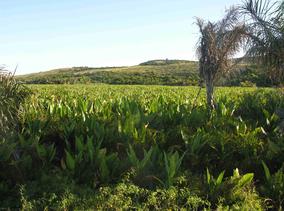You are here
Araceae
Typhonodorum lindleyanum Schott
SUMMARY
LEAVES: Tall plant of 2-4 m with numerous leaves; stem covered in vestigesremains of dead brown leaves; rhizome thick, creepingawling. Cataphylls long, attenuating progressively towards the apex. Petiole thick, green and fleshy 30-100 cm long (the top part free), sheathseeds very long, overlapping, hence forming a distorted false stem. Adult leaf blade 70-140 cm long, 55-58 cm wide; juvenile leaves clearly proportionally much smaller and narrower, the length to width ratio is 4 to 1; the midrib thick, 1-1.5 cm at the base, often accompanied by 3 primary veins borne each side at the base, 2 pairs of those orientated towards the base, one pair is orientated ± horizontally with each side, still 5-6 veins supplement the primaryand supplemented by 5-6 thick primary veins, running towards the top; numerous secondary lateral veins, very slender, ± parallel and orientated towards the edge. INFLORESCENCE: Peduncle 40-50 cm long, about 3 cm diameter, after fertilization, the Infructescence leans towards the base. Spathe 45-80 cm long, narrowing where the male and female flowers join, rolling into a tube at the base; bladeleaf elongated -lanceolate, acuminate, 3 times longer than the tube and 10-15 cm diameter, cream inside and outside, inside itthe lower part changes color during Infruitingctescence and becomes green; the topupper part and the male partzone of the spadix desiccates after fertilization, while the lower part is enveloped enclosed by the spathe while there are fruits. Spadix yellowish, 35-55 cm long, reaching 3 cm in diameter, berries inserted towards the base. Female part zone ± cylindrical, about 1/6 of the length of the spadix; male part zone more narrower, sterile at the base for an equalof equal length to the fertile part; upper part of the male zonepart also sterile and 1.7-2.2 cm diameter, attenuating in a cone., Ca. 3 times as long as the fertile part. Fertile male flowers with 4-8 stamens joined in a synandrium, ca. 5 mm long, 3 mm broad and 2 mm high, obpyramidal truncate, thecae touching the apex and the base of the synandrium, dehiscing towards the apex by a short slit; staminodes of the lower sterile male flowers joined in a flattened and squashed synandrium flattened and squashed, somewhat hexagonal and truncate towards the top,; those arranged towards the pistils, irregularly shaped; ovary ovoid to globose, reddish, ca. 3mm diameter with a sub-sessile stigma, disc ofwith 3-6 lobes, yellowish to reddish, ca 1.5 mm diameter; ovule ovoid to globose, orthotropous, attached by a very short funicle with basal placentation. INFRUCTESCENCE ca. 17 cm long, ca.12 cm diameter and 38 cm circumference, spathe green, rotting at maturity. The dried part of the male portion zone of the spadix ± early caducous. Berry ± globose to ovoid , more oftenusually a little flattened, ca 4 cm diameter, yellow when fresh, with 1(-2) seeds. Seeds obovoid, flattened, ca 3x3 cm, 1.5 cm thick, greenish brown, without endosperm; large embryo with a long plumule with 2-3 leaves which curve towards the apex of the seed in a semicircular way. Chromosome number 2n =112





